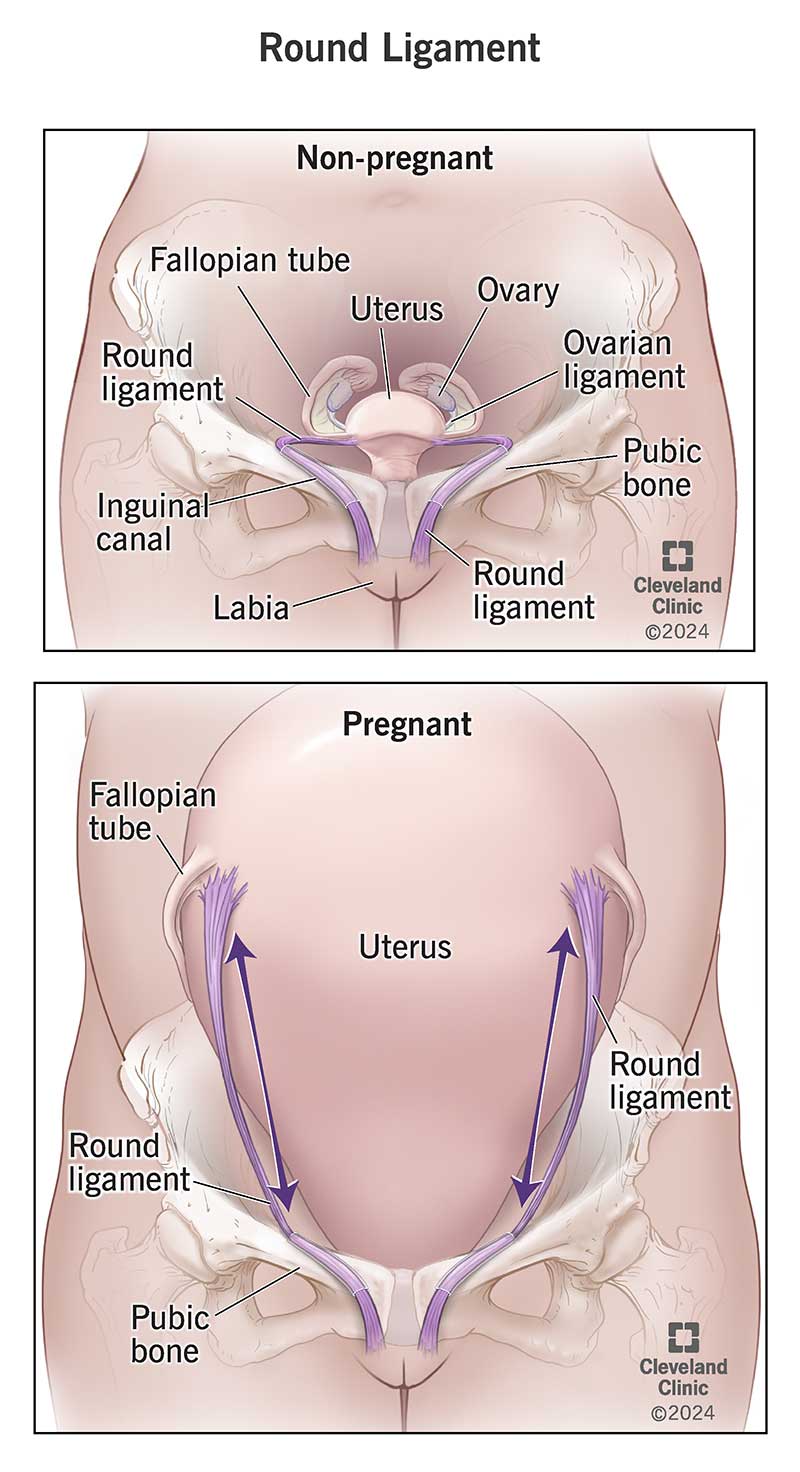The round ligament is a rope-like band of connective tissue. Two round ligaments support the uterus. During pregnancy, the round ligaments stretch as the uterus grows. Other conditions, including endometriosis and varicose veins, can also affect the round ligaments.
Advertisement
Cleveland Clinic is a non-profit academic medical center. Advertising on our site helps support our mission. We do not endorse non-Cleveland Clinic products or services. Policy

Round ligaments are ropelike bands of connective tissue that support your uterus. There are two round ligaments of the uterus, one on either side. Each is about 4 inches (10 centimeters) long. Round ligaments typically don’t contribute to any health problems, but they can overstretch and cause pain in your groin area during pregnancy.
Advertisement
Cleveland Clinic is a non-profit academic medical center. Advertising on our site helps support our mission. We do not endorse non-Cleveland Clinic products or services. Policy
The round ligaments develop from the gubernaculum, which is a tissue you can find in all fetuses during fetal development. When sex organs form, the round ligament of a female fetus helps connect the uterus to the outer lips of the vagina (labia majora). In a male fetus, the ligament moves down to its scrotum (sac that holds the testicles).
When people refer to “round ligaments,” they generally mean round ligaments of the uterus. Another round ligament, the round ligament of the liver, is what remains of the umbilical vein. This blood vessel carries blood from the placenta to the fetus during pregnancy.
Ligaments are strong bands of fibers interconnected in strong, cordlike ropes. Typically, ligaments attach bones in a joint. In places like your elbow, ligaments make crisscross connections that help stabilize the joint and help it move. Other ligaments, like the round ligament, help support your internal organs. Rather than connecting bones to stabilize a joint, the round ligament supports your uterus and connects it to the lower part of your abdomen.
The round ligaments exist to support organs in your pelvis. If you’re female, round ligaments support and anchor the uterus.
Advertisement
During pregnancy, the round ligaments are put under a lot of tension. They get wider and longer to support your uterus as it grows to accommodate a fetus. This tension can cause pain that radiates through your entire groin area.
Yes, males have round ligaments. Round ligaments typically don’t cause pain or health complications, so people may not know they exist.
There are two round ligaments, one on each side of your uterus.
Several structures come off the top corners of your uterus and briefly run together: the round ligament, the fallopian tube and the ligament that holds your ovaries close to your uterus. From there, the ligament enters your abdominal wall and travels through your groin (in the inguinal canal), and eventually inserts into the labia (vaginal lips). This is why round ligament pain in your vaginal area is common during pregnancy.
Several conditions can affect the round ligaments during your reproductive years. These include:
During pregnancy, your uterus grows and expands to accommodate a fetus. (Your uterus starts about the size of an orange and by the end of a pregnancy, it’s about the size of a watermelon.)
The round ligaments also expand to support your uterus as it gets bigger and heavier throughout pregnancy.
You may feel round ligament pain when these ligaments stretch to hold up your (now much larger) uterus during pregnancy.
During pregnancy, it may help to do gentle stretches of your pelvis and hips, but there isn’t one way to stretch your round ligament. If you experience round ligament pain, stop doing the movement and rest until it goes away. An abdominal binder can also help support your abdomen and improve round ligament pain.
You should call your provider if you experience severe round ligament pain that lasts more than a couple of minutes, along with:
The round ligaments help support your uterus. During pregnancy, your uterus grows and puts these ligaments under tension. This tension can cause pain in your groin, hips and pelvic area. Talk to your healthcare provider about how to recognize round ligament pain during pregnancy. They can talk to you about ways to help ease any pain your round ligaments cause.
Advertisement
Trying to choose where to give birth? Learn why Cleveland Clinic is the best choice to help you through each step of the labor and delivery process.

Last reviewed on 03/29/2024.
Learn more about the Health Library and our editorial process.